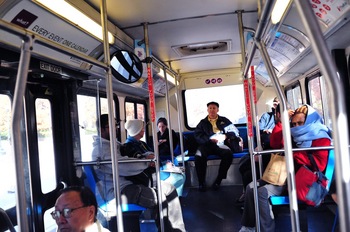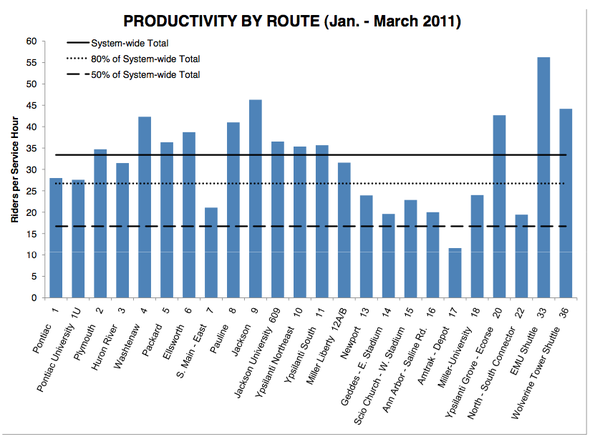Smart growth? Washtenaw County residents asked to chime in on AATA's countywide transit plan
The Ann Arbor Transportation Authority's governing board voted Thursday night to put the agency's "Smart Growth" Transit Master Plan out for additional public input.
A series of five public meetings will be held in mid-May to present the plan and continue a dialogue with Washtenaw County residents.
"A great deal of research, analysis and public input has led to the development of the Smart Growth vision," AATA Board Chairman Jesse Bernstein said in a statement.

Washtenaw County residents have several more opportunities to chime in on the Ann Arbor Transportation Authority's countywide transit plan before it moves forward.
Ryan J. Stanton | AnnArbor.com
The $465 million plan to expand transit services countywide over 30 years eventually will have to get past the Washtenaw County Board of Commissioners. And if discussions that took place earlier this month are any indication, that might be a tough hurdle to clear.
The plan also likely will require going to voters next year with a countywide millage request and a complete reorganization of the AATA as a new countywide transit authority
Bernstein said the AATA is aware some people still have questions about the plan, and further public input opportunities will make sure as many people as possible have a chance to take part in the ongoing discussion about Washtenaw County’s transit future.
The public meetings will be held from 6-8 p.m. on:
- Monday, May 9 — Chelsea Library, McKune Room, 221 S. Main St., Chelsea
- Tuesday, May 10 — SPARK East, 215 W. Michigan Ave., Ypsilanti
- Wednesday, May 11 — Ann Arbor District Library, Multipurpose Room, 343 S. Fifth Ave., Ann Arbor
- Monday, May 16 — Dexter Library, Lower level (large side), 3255 Alpine, Dexter
- Tuesday, May 17 — Saline City Hall, 100 N. Harris St., Saline
AATA began developing the Transit Master Plan last summer. Officials said the process involved extensive public outreach, including more than 60 community meetings, workshops with 45 county leaders, more than 200 in-person interviews, and online and paper questionnaires completed by more than 2,500 residents.
The AATA has used community meetings and demographic research to determine residents’ transportation needs and to identify long-term goals. Among the challenges outlined are the growing population of aging Baby Boomers, increasing traffic congestion and the growing need among residents without cars for getting to critical destinations.
AATA CEO Michael Ford noted an overwhelming majority of residents who have provided feedback are supportive of the plan. He said the agency continues to take a hard look at the Smart Growth scenario, including funding options and ways to phase it in over 30 years.
“It’s important to remember that the Transit Master Plan will never be set in stone — it’s more of a vision of where we want to be in 30 years," Ford said in a statement, adding now that the board has voted to accept the plan, next month's public meetings are the next step in carrying forward an ongoing dialogue to hopefully make the plan a reality.

This chart showing the number of riders per service hour on existing AATA routes was included in the board's packet Thursday night. The Eastern Michigan University shuttle topped the list.
Ryan J. Stanton covers government and politics for AnnArbor.com. Reach him at ryanstanton@annarbor.com or 734-623-2529. You also can follow him on Twitter or subscribe to AnnArbor.com's e-mail newsletters.


Comments
braggslaw
Fri, Apr 22, 2011 : 11:58 a.m.
who in their right mind would pay $50,000 per rider? we could buy them a $10,000 compact and pay gas and insurance for 20 years
braggslaw
Fri, Apr 22, 2011 : 11:44 a.m.
<a href="http://www.templetons.com/brad/transit-myth.html" rel='nofollow'>http://www.templetons.com/brad/transit-myth.html</a>
murph
Fri, Apr 22, 2011 : 12:20 p.m.
Let's see if I got the point of that link: at 9 passengers/hour, standard diesel transit buses are "only" 20% more energy efficient than the average single-occupant car. So if I do the math for 33 passengers, it looks like a standard diesel bus is about 80% more energy efficient than the average single-occupant car, and about 66% more energy-efficient than a car with an "average" 1.57 occupants. That's without even considering the hybrid nature of most of AATA's fleet. For a better view of the value of transit, from a view that might appeal even if you like to hate the environment, I'd suggest, for example, William S. Lind's work at The American Conservative magazine's Center for Public Transportation: "The revolution in personal mobility came first not with the automobile but with the electric railway and the safety bicycle (we like bikes as well as trains; in my last few years with Free Congress Foundation, I cycled to work). Trains, interurbans, streetcars, boats on inland and coastal waterways and bicycles once offered Americans the ability to from anywhere in the country to anywhere else in the country, without driving and without flying. We could still do that, for the most part, up into the 1950?s. Then we did something that conservatives warn against: we threw away what we had that worked and went with "the latest thing," complete dependence on automobiles. Few asked when domestic sources of petroleum would prove inadequate to fuel all those cars. Now, we know, as our mobility hangs by a thread, dependent on events in unstable parts of the world."
braggslaw
Fri, Apr 22, 2011 : 11:36 a.m.
at 35 average riders an hour AATA does not pencil... with the expanded "dumb" growth option the number of riders will drop dramatically leading to higher costs, more greenhouse gases (than people driving their own cars), and a huge political white elephant.
KJMClark
Fri, Apr 22, 2011 : 11:21 a.m.
Did everyone notice those gas prices starting to go over $4 a gallon this week? Anyone want to take bets it'll be over $5 this summer? The IRS says it's over 50cents per mile. Wouldn't it be nice to have some alternatives?